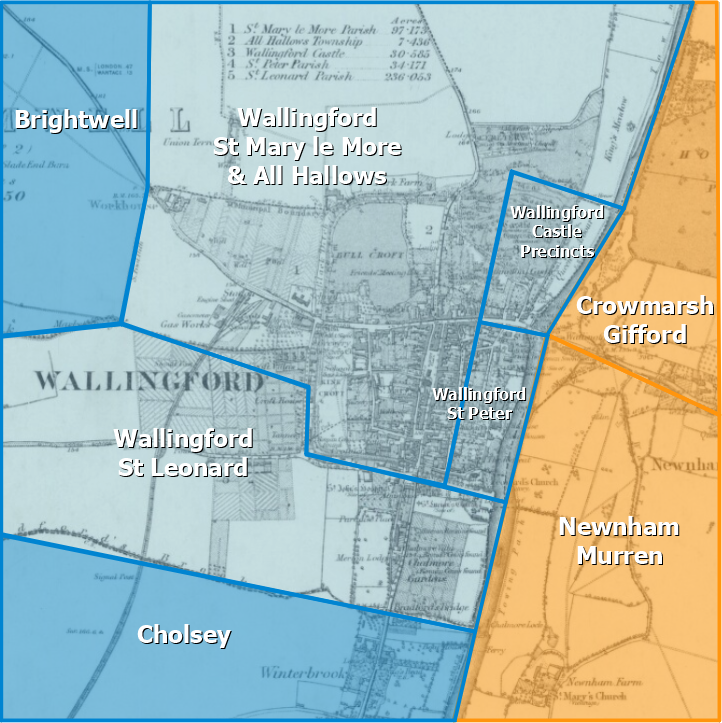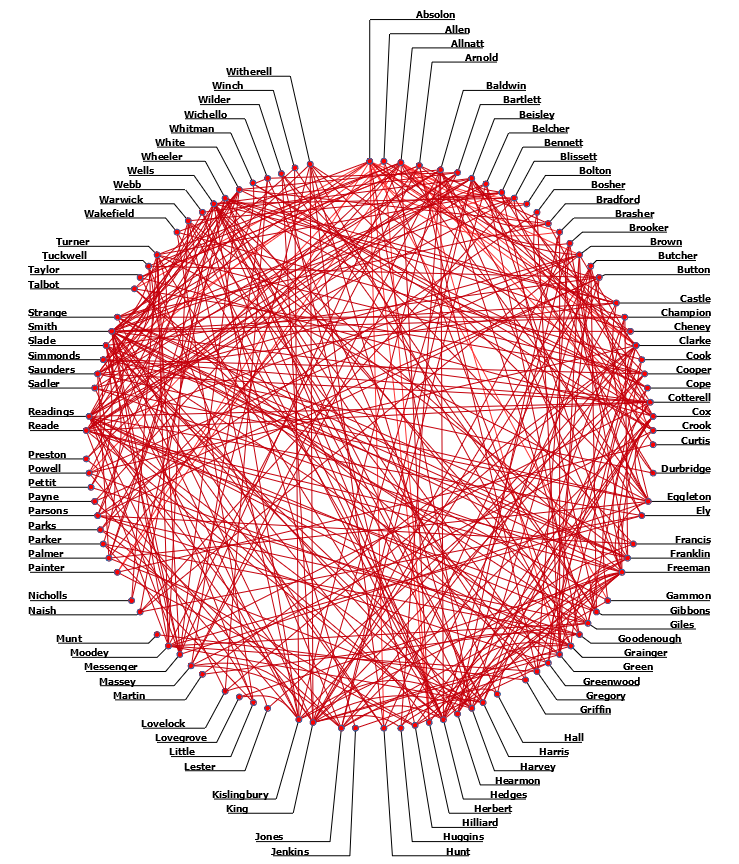

One hundred families, two hundred years: Wallingford and its residents 1750-1950
Wallingford (Oxfordshire, not any of the five USA spinoffs) is a small English market town, possessing a strategic bridge over the River Thames and at various times stradling the Berkshire/Oxfordshire boundary. Wallingford had massive historic significance: see, for example, the town's museum and its related Historical and Archeaological Society, British History Online, and Wikipedia. It was once the residence of English royalty, but in this study we are looking at its more humble inhabitants, from about 1750 onwards.
The town is located 12 miles SE of Oxford and 15 miles NW of Reading; historically it lay in the Moreton Hundred (a ‘hundred’ was the division of a county for administrative, military and judicial purposes and comprised enough land to sustain approximately one hundred households). Long ago it had thirteen churches, but the upheavals of the English Civil War reduced that number to the three that survive today: St Mary le More, St Leonard and St Peter. (Coincidently – and maybe more surprisingly – there has also been a sharp decrease in the number of pubs.) This study concentrates on the residents of those three central parishes (plus the Castle Precincts, an extra-parochial oddity with a mere handful of residents), but also includes many from surrounding parishes, primarily Benson (then called Bensington), Crowmarsh Gifford, Newnham Murren, Cholsey, Brightwell and Sotwell.
On this 1851 map of Wallingford, the approximate outlines of the central parishes are shown in blue (Berkshire) or orange (Oxfordshire). Notice how the land north and west of the Bullcroft, and also south of St John's Road, is almost totally undeveloped. You can see the Workhouse on the western edge of the parish, and the C&W railway terminating on – of course – Station Road.

Discounting short-stay residents, some 1,600 surnames can be found in this area over the period of the study; the ten most common, in descending order, are: Smith, Green, Wells, Cox, Hedges, King, Freeman, Saunders, Wheeler, and Clarke; each has over 200 residents. Historically, surnames varied considerably in their spelling; here, those variations have been merged into one consistent version, so that “Castle” covers also “Castell”, “Simmonds” ditto for “Simmons”, and so on. Likewise for given names; for example, “Anna”, “Anne” and “Annie” are all recorded as “Ann”.
To give the study a little focus, we pay particular attention to 100 families whose impact on the town has been significant:
| Click on any of these surnames to see its ‘roots’ – a shorcut to local male individuals of that name who currently have (a) one or more identified descendants, and (b) no identified ancestors. Or, click to see an alphabetic list of over 26,000 individuals – sharing surnames from Abbott to Young – that I've so far traced (at least to some degree). A “(w)” before a surname indicates a widow or widower. The initials “NYI” remind us that this person's parentage is Not Yet Identified. |
Naturally, in a relatively small community like Wallingford, these primary 100 families have frequently inter-married. This diagram shows many of the linkages:

In earlier times, large families were much more common than nowadays. Notable examples here include James Brasher and Martha Spirit (married 1814, 17 children); James Butcher and Eliza Hunt (m. 1848), also Thomas Simmonds and Clara Cooper (m. 1871), both familes with 15 children; and James Goodenough and Sarah Baldwin (m. 1821), John Harvey and Alice Ashley (m. 1850), also George Hobbs and Alice Church (m. 1862), all with 14 children. At least 10 families have 13 children, at least 33 families have 12 children, and so on.
Popular given names for girls, in descending order, are: Mary, Ann, Elizabeth, Sarah, Jane, Martha, Eliza, Ellen, Hannah and Frances, and for boys are: William, John, James, Thomas, George, Henry, Charles, Richard, Frederick and Robert. William occurs over 1600 times, with Mary nearly as many; each of the others occurs at least 250 times. Some of the less common names, with only one example found, include (girls): Abigail, Belinda, Charity, Delilah, Eugenia, Faith, Gillian, Honor, Isis and Jubilee, and (boys): Abijah, Beauclerc, Colin, Dudley, Ethelbert, Ferdinand, Gad, Hamlet, Ishmael and Jabez.
One of the interesting facts to come out of this research is the employment of its residents. These are the top ten occupations: Labourer, Carpenter, Cordwainer, Tailor, Farmer, Baker, Painter & Decorator, Bricklayer, Grocer and Blacksmith. The preponderence of Labourers (both Agricultural and Industrial) – six times as many as Carpenters – is no surprise, but... so many Cordwainers (boot/shoe makers), so many Tailors; when and where did they all go? And over 60 Bakers; nowadays, if only...
Historically, Wallingford was the major parish in the Wallingford Borough Poor Law Union (parishes were grouped into ‘unions’, jointly responsible for the administration of poor relief in their areas). The Wallingford Union Workhouse, replacing an earlier and much smaller institution, was built in 1807 to house 280 inmates, and extended in the 1830s to house 380 inmates; from the census returns, it seems to have always been full. It became a hospital in 1948, and finally closed in 1982; it was situated on the north side of Wantage Road, nowadays the location of Atwell Close and the Wallingford Christian Assembly. Because of the incompleteness of the census data on workhouse inmates, they have not been included in this study.
That's about it; for other local background, try a google on "history of wallingford oxfordshire". I'm grateful to the Oxfordshire Family History Society and to Ancestry.co.uk for the research resources they provide. Finally, please note that I'm a data miner rather than a historian, and that this study is neither definitive nor complete; if you have more accurate information then you're welcome to let me know.
Contact me at roger@firthworks.com
with queries, comments or corrections.
Modified 8 November 2017